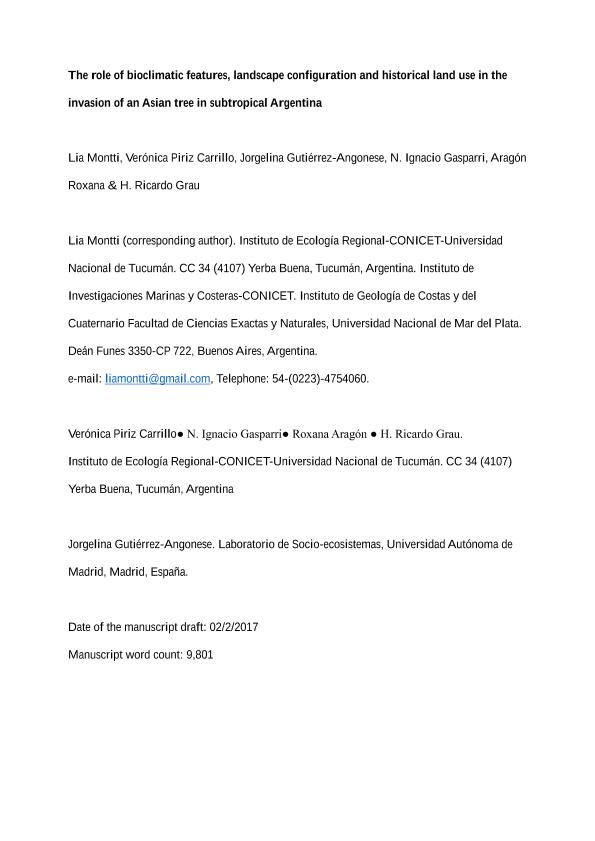Mostrar el registro sencillo del ítem
dc.contributor.author
Montti, Lia Fernanda

dc.contributor.author
Piriz Carrillo, Veronica Raquel

dc.contributor.author
Gutiérrez Angonese, Jorgelina

dc.contributor.author
Gasparri, Nestor Ignacio

dc.contributor.author
Aragón, Myriam Roxana

dc.contributor.author
Grau, Hector Ricardo

dc.date.available
2018-08-22T18:56:29Z
dc.date.issued
2017-11
dc.identifier.citation
Montti, Lia Fernanda; Piriz Carrillo, Veronica Raquel; Gutiérrez Angonese, Jorgelina; Gasparri, Nestor Ignacio; Aragón, Myriam Roxana; et al.; The role of bioclimatic features, landscape configuration and historical land use in the invasion of an Asian tree in subtropical Argentina; Springer; Landscape Ecology; 32; 11; 11-2017; 2167-2185
dc.identifier.issn
0921-2973
dc.identifier.uri
http://hdl.handle.net/11336/56668
dc.description.abstract
Context: Knowing which factors determine the spread of plant invaders is a relevant issue in global ecology. Cultural landscapes both influence and are affected by exotic species. Although bioclimatic boundaries, seed sources and landscape configuration all control the invasion process, they have been mostly studied separately and independently from their distant drivers. Objectives: We followed a multiscale approach to describe the invasion dynamics of the Asian tree (Ligustrum lucidum) in subtropical NW Argentina cultural landscapes by: (1) identifying the potential bioclimatic area of invasion, (2) mapping the currently invaded area in peri-urban focal sectors, and (3) quantitatively describing the landscape-scale patterns of invasion in relation to environmental and cultural variables. Method: Niche models were used to map potential invasion area, remote sensing, GIS and field surveys to map patterns of invasion and their association to landscape and environmental variables. Results: Climate suitability to L. lucidum extends over important ranges of the studied area, but currently invaded areas are mostly restricted to clusters around the main cities. The historical and demographic features of cities (e.g., date foundation, population) are important in predicting invaded forest location and spread. At local scale, invasion is associated to abandoned fields nearby urban centers, roads and rivers. Conclusions: The invasion patterns of L. lucidum reflect the combined effect of historical socioeconomic connections between Asia and America, as well as the local cultural landscape history and configuration. Teleconnected cultural landscapes need to be explored as a theoretical framework for the study of biological invasions in the Anthropocene.
dc.format
application/pdf
dc.language.iso
eng
dc.publisher
Springer

dc.rights
info:eu-repo/semantics/openAccess
dc.rights.uri
https://creativecommons.org/licenses/by-nc-sa/2.5/ar/
dc.subject
Invasive Species
dc.subject
Ligustrum Lucidum
dc.subject
Species Distribution
dc.subject
Telecoupled Cultural Landscapes
dc.subject.classification
Otras Ciencias Biológicas

dc.subject.classification
Ciencias Biológicas

dc.subject.classification
CIENCIAS NATURALES Y EXACTAS

dc.title
The role of bioclimatic features, landscape configuration and historical land use in the invasion of an Asian tree in subtropical Argentina
dc.type
info:eu-repo/semantics/article
dc.type
info:ar-repo/semantics/artículo
dc.type
info:eu-repo/semantics/publishedVersion
dc.date.updated
2018-08-21T13:45:52Z
dc.journal.volume
32
dc.journal.number
11
dc.journal.pagination
2167-2185
dc.journal.pais
Alemania

dc.journal.ciudad
Berlin
dc.description.fil
Fil: Montti, Lia Fernanda. Universidad Nacional de Tucumán. Instituto de Ecología Regional. Consejo Nacional de Investigaciones Científicas y Técnicas. Centro Científico Tecnológico Conicet - Tucumán. Instituto de Ecología Regional; Argentina. Consejo Nacional de Investigaciones Científicas y Técnicas. Centro Científico Tecnológico Conicet - Mar del Plata. Instituto de Investigaciones Marinas y Costeras. Universidad Nacional de Mar del Plata. Facultad de Ciencia Exactas y Naturales. Instituto de Investigaciones Marinas y Costeras; Argentina
dc.description.fil
Fil: Piriz Carrillo, Veronica Raquel. Universidad Nacional de Tucumán. Instituto de Ecología Regional. Consejo Nacional de Investigaciones Científicas y Técnicas. Centro Científico Tecnológico Conicet - Tucumán. Instituto de Ecología Regional; Argentina
dc.description.fil
Fil: Gutiérrez Angonese, Jorgelina. Consejo Nacional de Investigaciones Científicas y Técnicas; Argentina. Universidad Autónoma de Madrid; España
dc.description.fil
Fil: Gasparri, Nestor Ignacio. Universidad Nacional de Tucumán. Instituto de Ecología Regional. Consejo Nacional de Investigaciones Científicas y Técnicas. Centro Científico Tecnológico Conicet - Tucumán. Instituto de Ecología Regional; Argentina
dc.description.fil
Fil: Aragón, Myriam Roxana. Universidad Nacional de Tucumán. Instituto de Ecología Regional. Consejo Nacional de Investigaciones Científicas y Técnicas. Centro Científico Tecnológico Conicet - Tucumán. Instituto de Ecología Regional; Argentina
dc.description.fil
Fil: Grau, Hector Ricardo. Universidad Nacional de Tucumán. Instituto de Ecología Regional. Consejo Nacional de Investigaciones Científicas y Técnicas. Centro Científico Tecnológico Conicet - Tucumán. Instituto de Ecología Regional; Argentina
dc.journal.title
Landscape Ecology

dc.relation.alternativeid
info:eu-repo/semantics/altIdentifier/doi/https://dx.doi.org/10.1007/s10980-017-0563-2
dc.relation.alternativeid
info:eu-repo/semantics/altIdentifier/url/https://link.springer.com/article/10.1007/s10980-017-0563-2
Archivos asociados
